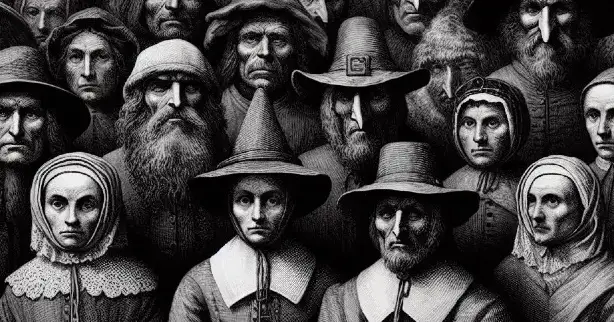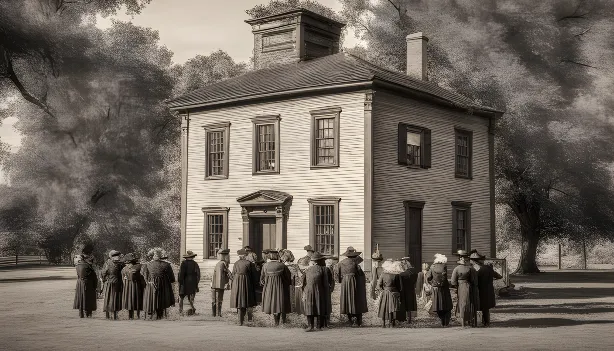In the picturesque seaside town of Ayr on Scotland’s rugged west coast, the tragic witch trial of Elspeth Cuninghame happened during the 17th-century witch hunts. This event took place just before the Age of Enlightenment (1685–1815), a time when reason and science began to rise. Despite these advances, many still believed in witches and evil spirits. Elspeth Cuninghame’s trial shows the harsh reality faced by those accused during times of fear and ignorance, reflecting the larger witch hunt that affected many communities across Scotland and beyond.
The Tragic Tale of Elspeth Cuninghame: From Farm Owner to Victim of a 17th-Century Witch Hunt

Although much of Elspeth Cuninghame’s life remains shrouded in mystery, we know that in 1669, she and her husband owned and managed Cuninghame Farm in Ayr. The farm’s prime location, with fertile soil for farming and easy access to the sea, likely ensured a prosperous life, with ample opportunities for both agriculture and fishing.
However, tragedy struck when Mr. Cuninghame suddenly passed away, leaving Elspeth to face the future alone. This devastating loss marked the beginning of a difficult period for Elspeth. At that time, women had almost no legal rights, they couldn’t own property, run businesses, or serve as witnesses in court.
Instead of the community coming together to support Elspeth as she grieved her husband, she was shunned, and the process of forcing her from her beloved homestead began soon after. Under immense pressure, Elspeth Cuninghame found herself at the centre of a literal witch hunt. As the townsfolk tried to force her out, she began drinking heavily, often getting into public arguments. But things took a turn for the worse when the local tavern refused to serve her ale. In a fit of rage, she knocked several jugs off the bar. She was soon charged with several offenses, including claims that she bewitched a drunken man into beating his wife, caused the destruction of an alehouse after being denied a drink, and spoiled someone else’s ale. Quarrels followed Elspeth everywhere, leaving her with few friends.

Elspeth Cuninghame’s Trial and Execution in the Scottish Witch Trials
While imprisoned in the village jail on charges of witchcraft, Elspeth was subjected to a brutal test known as “pricking.” This barbaric practice involved jabbing pins into skin blemishes and birthmarks, believed to be “devil’s marks.” If the accused felt no pain or if no blood was drawn, these marks were deemed conclusive evidence of witchcraft. In Elspeth’s case, five witnesses testified that a pin was thrust into her skin without causing her pain or drawing blood. This damning testimony played a pivotal role in sealing her fate as a witch.
The Scottish legal system during the witch trials was notoriously unjust, almost always favouring the accusers. This was evident in the trial of Elspeth Cuninghame. In a cramped, dimly lit courtroom, 25 accusers stood against her, while 30 witnesses looked on. The atmosphere would’ve been tense and silent. A 15 man jury, swayed by fear and superstition, quickly found her guilty. Her sentence was both brutal and final: strangulation followed by burning her body to ash. This tragic outcome highlights the extreme cruelty and injustice of that era.

Revisiting Elspeth Cuninghame: Lessons from a Witch Trial
Nearly five centuries later, it is crucial to re-examine Elspeth Cuninghame’s alleged guilt with a more compassionate and informed perspective. Her lesser-known yet insidious witch trial offer a dark insight of the mind sets and beliefs of our ancestors. The tragic and violent outcome of her trial underscores the perilous combination of ignorance, fear, and a deeply flawed legal system. This dark chapter in history reveals the dangers that arise when society lacks proper education and allows fear to override reason, leading to irreversible harm and injustice.
Quick Summary of witchcraft Trials:
-
- From 1400 to 1775, approximately 100,000 people were prosecuted for witchcraft across Europe and British America. Of these, between 40,000 and 60,000 were executed. The height of witchcraft prosecutions occurred from 1560 to 1630, largely driven by the Counter Reformation and ongoing religious wars. During this period, accusations were often made by neighbours, predominantly targeting lower-class individuals, and formal charges became a common occurrence.
-
- Notably, around 80% of those convicted were women, with a significant number being over 40 years old. In certain regions, the convicted were subjected to execution by burning at the stake, a brutal method reflecting the intense fear and superstition surrounding witchcraft at the time.

Leave a Reply